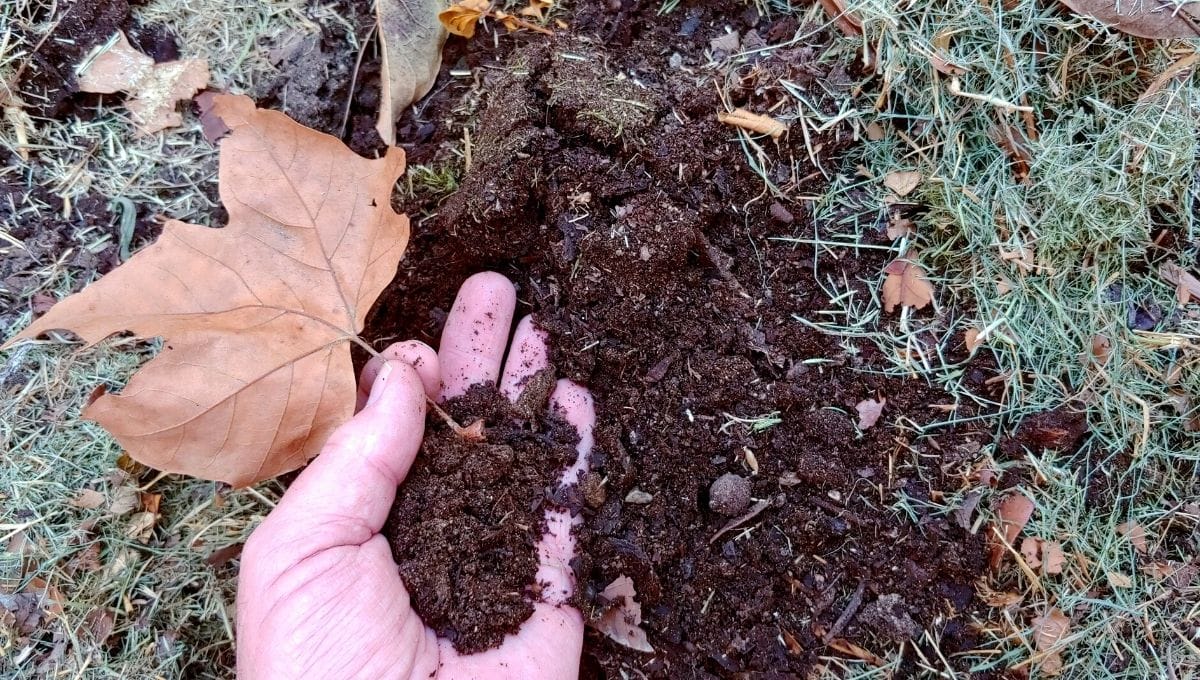
Is your lawn covered with leaves and you aren’t sure what to do with them? Try composting them to create a perfect amendment for your soil. Composted leaves build soil structure, improve water retention, reduce compaction, encourage earthworms, balance soil pH, and feed your plants.
Leaves can be added to the compost bin to provide “brown” or carbonaceous material that will create food for your plants that is high in nitrogen. Most compost heaps require a mix of 1 part brown matter to 1 or 2 parts green material to create the ideal conditions for decomposition. Compost heaps or bins should ideally be piled 4 feet high, and just as deep and wide, and should be turned regularly.
Alternatively, you can make leaf mould that will be low in nitrogen but will add valuable humus to your soil.
Leaf mold is easy to make by piling your freshly raked leaves and letting them slowly decompose for a year or two, or you can speed up the process by putting them in a plastic bag.
Here is a guide on how to compost leaves to use in your garden, plus some answers to important questions about composting leaves.
Leaf Compost VS Leaf Mold
Leaf compost and leaf mold both use microorganisms in the soil to decompose leaves, but there are several differences.
Composting uses heat and oxygen-loving bacteria to quickly break down leaves to create a compost that is high and nitrogen and provides food for your plants.
Leaf mold is a cool process where nitrifying bacteria decompose the leaves into a rich humus.
Leaf Compost
Composting with leaves is when you add leaves to your compost bin or heap.
To make compost, garden waste, kitchen scraps, straw, animal manure, and of course leaves are mixed together and decompose to create a nutrient-rich soil amendment that is added to your garden to feed the plants and build the soil.
The pile is turned regularly to let in oxygen and keep the temperature of the pile hot.
The compost pile is a mix of “brown” carbon material and “green” nitrogen matter.
Microorganisms in the soil consume this matter and break it down into a sweet-smelling humus.
These microorganisms consume about 30 times as much carbon matter as nitrogen, so you want to have the pile balanced for ideal decomposition.
This 30:1 ratio is a scientific measure, and in actuality, you want to add brown to green matter at a rate of about 1:1 or 1:2 to your compost bin.
This is because the leaves that you add contain very high levels of carbon (often 80:1 carbon to nitrogen ratio) so a little goes a long way.
Leaf Mold
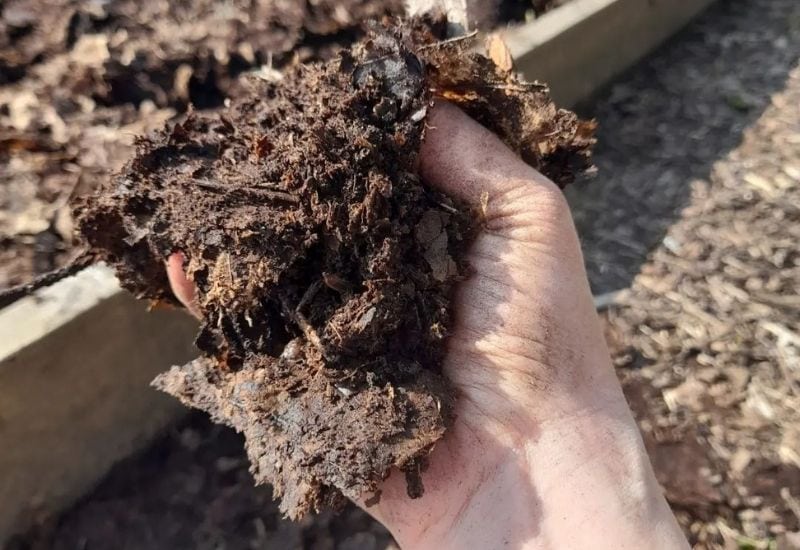
Leaf mold is very easy to make and very good for your garden. While the finished product is low in nitrogen, it adds lots of beneficial humus to your soil or potting mixes.
Leaf mold is an excellent environmentally-friendly replacement for sphagnum peat moss.
Leaf mold is basically a pile of leaves that slowly decomposes.
The thick pile of leaves quickly mat together and exclude oxygen, and the anaerobic environment encourages nitrogen-consuming fungi which create a black, sweet, humus that can be applied to your garden.
Benefits Of Composting Your Leaves
The arduous task of raking leaves in the fall can become one of the most beneficial tasks you can do for your garden.
Composted leaves create a dark humus that is rich in organic matter. The larger particle size improves soil structure by enhancing aeration and water retention and loosens heavily compacted soils. Leaf compost also provides readily available plant food in an easy-to-use form, and the leaves are a great food source for earthworms and other beneficial organisms and bacteria that live in the soil.
Another great benefit of using leaves to make compost is that they are free. Not only that, nature provides an abundance of them every year.
If you don’t have very many trees on your property, most people are willing to give bags of them away, so ask your neighbors or local landscape companies.
Raking leaves for your garden is also a great way to help elderly or incapacitated folks in your neighborhood.
Problems With Composting Leaves
While leaves contain tons of nutrients and are great for your soil, there are a few things to watch out for when composting leaves in your garden:
Matting
The main problem with leaves in the garden is that they mat. While this is a benefit for making leaf mould, leaves can clump together in the compost bin and inhibit proper decomposition. Shredding the leaves is a simple solution to this.
Lignin
Some leaves also take a long time to break down. Lignin is found in all leaves and it actually inhibits decomposition. Leaves such as oak, beech, birch, holly, and sweet chestnut contain higher levers of lignin and can take up to two years to fully break down.
Avoid eucalyptus and black walnut altogether as they contain natural herbicides that negatively affect your garden.
Tie Nitrogen In The Soil
You might be tempted to till leaves directly into your soil, and while this can be beneficial in small quantities, large amounts of raw leaves can cause problems with your soil.
As the microorganisms in the soil try to break down the leaves, they will find a lot of carbon to eat but not very much nitrogen so they will consume nitrogen from the soil and your plants can actually become nitrogen deficient. This is sometimes referred to as tying or binding nitrogen in the soil.
If you want to use leaves without composting them first, consider applying them as a mulch or try trench composting.
How Long Does It Take To Compost Leaves?
Well-made leaf compost can take as little as a few weeks, or it can take several months. Some ways to speed up the decomposition process include shredding the leaves prior to composting, turning the pile weekly, and making sure there is a proper carbon to nitrogen ratio.
Another factor that greatly affects your compost schedule is your climate and unfortunately, there isn’t too much you can do about that.
Remember that well-rotted leaf mould can take up to two years to be fully composted.
We will look at methods to accelerate this below.
In most climates, decomposing will stop during the cold winter months. In our area, our compost freezes solid from November to April, and I am always slightly jealous of gardeners who live in temperate climates where they can turn their bins throughout the winter months.
How To Compost Dry Leaves In A Bin Or Pile
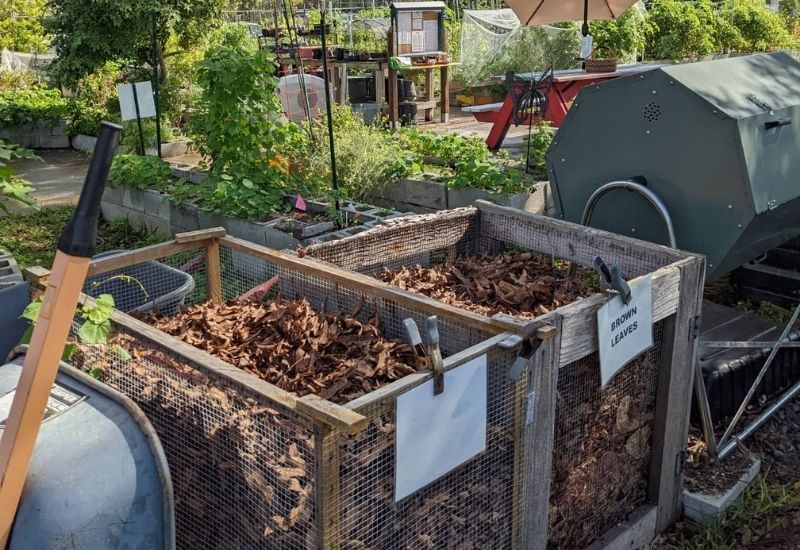
Compost is easy to make and the best way to improve soil health and build fertility. You can easily make compost in a pile or there are a number of bins your can buy or build yourself.
Here’s how to make leaf compost to feed your garden:
Gather The Leaves
If you choose to make compost purely from leaves, then you will need to gather lots of them.
Otherwise, use what you have available to mix in with other composting materials. Gather whatever leaves you have on hand (with the exception of black walnut and eucalyptus), or whichever leaves are readily available in your area.
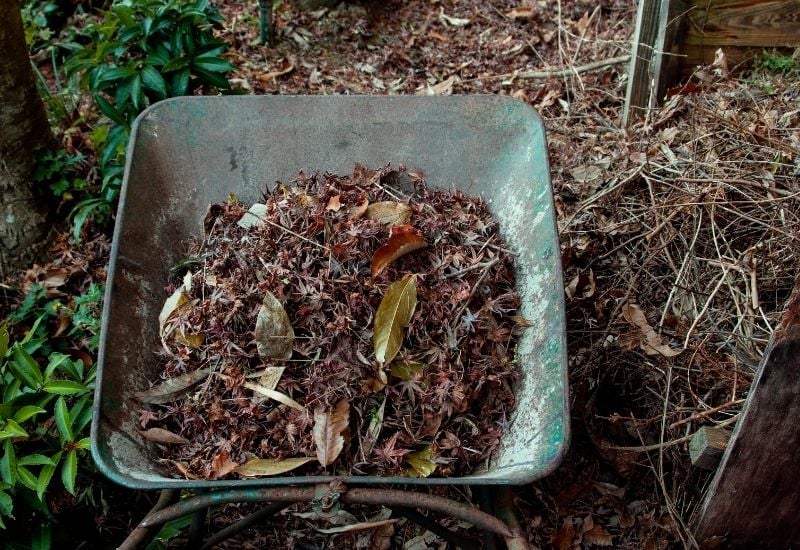
Leaves that have freshly fallen contain more nitrogen and so will aid decomposition. Old, dry leaves can still be used but they will take longer to break down.
Shred The Leaves
Shredded leaves decompose faster than whole leaves, so it might be beneficial to take the time to complete this step. Shredding will also keep the leaves from matting inside the compost pile and inhibiting decomposition.
Mow over the leaves with a mower bag attached, or just rake up the pieces afterward. Alternatively, you can buy a leaf shredder or leaf vacuum to speed up the process.
Fill The Compost Bin
You can make compost in a commercially purchased composted, in a homemade compost bin, or by simply piling the leaves and other materials together in the corner of the garden.
Whichever path you choose, the ideal size for a compost bin is about 1.25 meters (4 feet) deep 1.25 meters wide and 1.25 meters high. This size is large enough to heat sufficiently while still being manageable.
Add the leaves to your compost pile or bin, alternating them with “green” nitrogen matter such as grass clippings or kitchen scraps. Add the leaves at a ratio of about 1:1 or 1:2 with the greens.
Turn The Pile
Turn the pile regularly to keep the heat and decomposition process going. Every week is ideal, but try to aim for at least once a month.
Add a bit of water if your pile seems overly dry when turning. If the compost seems to wet, add more leaves, straw, or woodchips.
If you never seem to have time to turn your compost, consider “cold composting” which is basically to make a pile of your leaves and other material, and simply leave it.
This process is not as effective as “hot” composting and it will take a year or two before the compost is ready, but you will still have wonderful compost to add to your soil in the end.
If you find your compost is becoming too hot, you can aerate it by drilling holes in a piece of pipe and sticking it into the middle of the pile.
Wait For It…
Your leaf compost will be ready when it looks like dark, sweet-smelling soil with a light crumbly texture. How long your compost takes depends on how often you turn it.
Making Leaf Mold In Garbage Bags In 6 Months
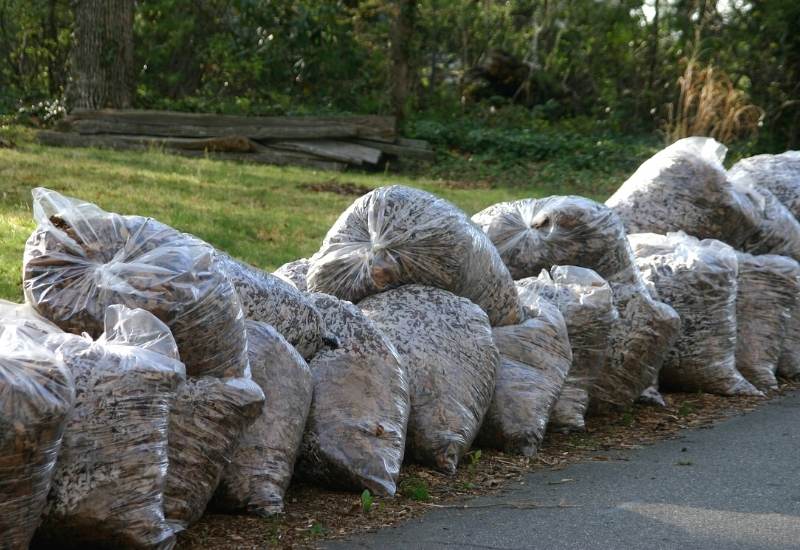
Leaf mould can be made by simply piling leaves in a heap and waiting a year or two. Alternatively, you can make a small wire cage and fill it full of leaves for a more contained pile.
However, here is another method of making leaf mold in a garbage bag that can give you more speedy results.
Gather Your Leaves
Gather together enough leaves that will fill a green garbage bag. Choose leaves that will decompose faster such as poplar, willow, ash, maple, and leaves from fruit trees.
Try and choose freshly fallen leaves as they will have a higher nitrogen content which will accelerate decomposition.
Shred The Leaves
While this step isn’t necessary it will greatly speed up the process. The easiest way to shred your leaves is to mow them (preferably with a mower bag attached), but you can also buy leaf shredders or leaf vacuums that have a shredder attachment if you plan on making a lot of leaf mould.
Fill The Bag
Fill a large garbage bag with your shredded leaves. Moisten them lightly and seal the bag. Poke holes in the bag to allow some airflow, and put it in a convenient location.
Turn The “Pile”
Typically, leaf mould is left undisturbed, but turning it can help speed things up. Every few weeks, roll the back around or give it a shake to turn the leaves.
Check The Moisture
Every month or two, check to make sure the leaves are not drying out (remember, leaf mould is an anaerobic process that requires moisture for the fungi to work properly). If needed, add water to the bag of leaves.
Ready To Go
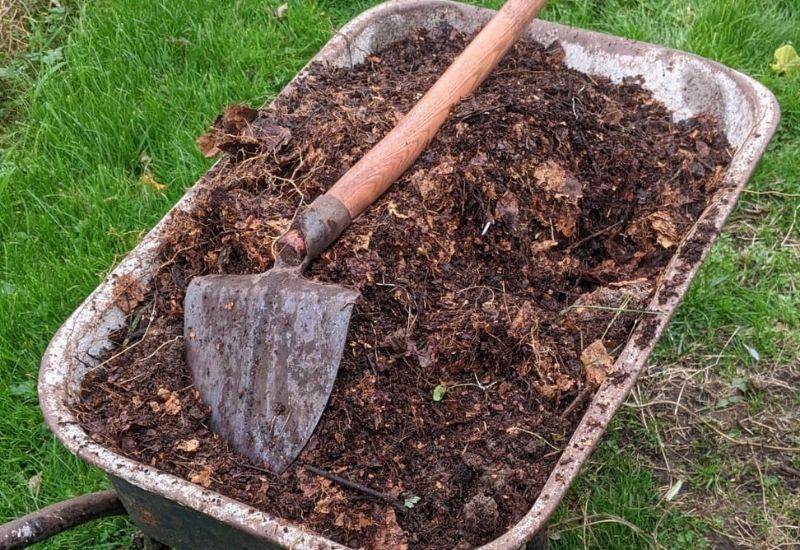
Your bagged leaf mould should be fully decomposed in about 6 months or so. It will be ready to use when it is dark, sweet smelling, and slightly crumbly.
How To Use Leaf Compost And Leaf Mold In Your Garden
Leaf compost can be mixed right into the soil. Add it either to your garden beds or to your potting mixes. Composted leaves are so good for your garden, it would be hard to add too much.
It can also be used as a mulch or top dress in your vegetable garden. As a rule of thumb, don’t apply more than 7 cm (3 inches) at a time.
Do not pile it right against your plants, especially perennials, as leaf mold and leaf compost can retain so much moisture that they can rot out the plants or introduce diseases and pests.
Conclusion
Fall is a beautiful time of year. The magnificent colors of the leaves as they change and fall from the trees can have even more significance to the gardener when we realize how beneficial they can be for the land we are cultivating.
Let’s utilize this pure and ever-abundant gift from nature by making compost and leaf mold, and our gardens will thank us for it.

Written By
Amber Noyes
Amber Noyes was born and raised in a suburban California town, San Mateo. She holds a master’s degree in horticulture from the University of California as well as a BS in Biology from the University of San Francisco. With experience working on an organic farm, water conservation research, farmers’ markets, and plant nursery, she understands what makes plants thrive and how we can better understand the connection between microclimate and plant health. When she’s not on the land, Amber loves informing people of new ideas/things related to gardening, especially organic gardening, houseplants, and growing plants in a small space.
